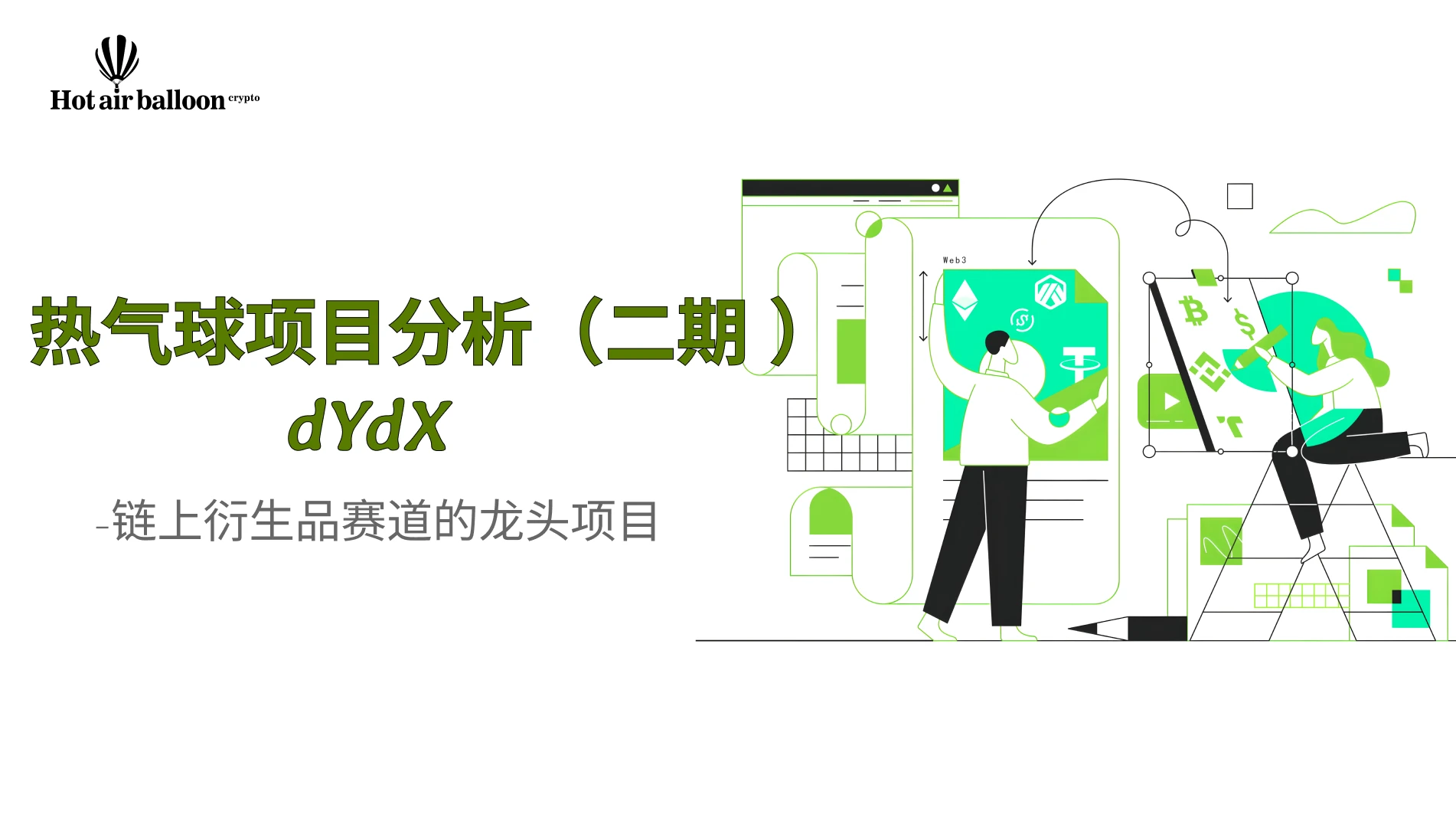
1. Project Introduction
1. What is dYdX
dYdX is the world's first decentralized cryptocurrency derivatives trading platform, aimed at establishing more open, transparent, and secure financial products through decentralized technology.
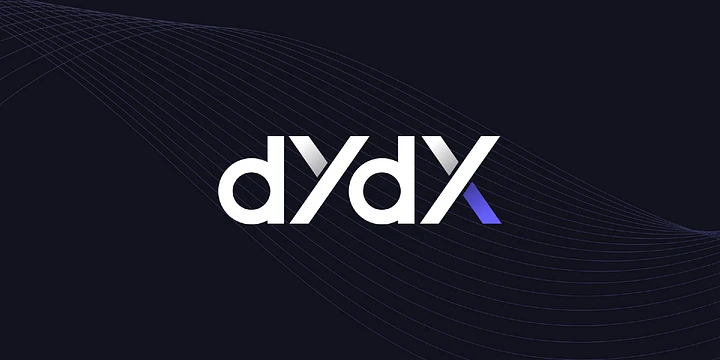
In the dYdX platform, it mainly supports margin (leverage) trading and derivative (perpetual contract) trading, with a maximum leverage of 20 times.
2. Product Architecture
1) Main Trading Mode
As we all know, AMM (Automated market maker) is one of the foundational protocols of DeFi. In the AMM model, the counterparty is a liquidity pool, and the liquidity pool provides real-time quotes, which is equivalent to trading with automated systems. There is no need to wait for the platform's trade matching, so transactions can be completed quickly. This is the advantage of the AMM model.
Classic DeFi projects such as Uniswap (DEX), Pancakeswap, and GMX (derivatives) all adopt the AMM model.
However, dYdX took a different approach and did not adopt the popular AMM model. Instead, it uses the order book model that has been used by centralized exchanges (CEX) for a long time.
On the dYdX platform, users can place market and limit orders, as well as 5 different stop loss modes. Additionally, they can set the expiration time for their orders.
dYdX believes that the order book model is better suited for professional traders and also meets the needs of more cryptocurrency traders. After all, centralized exchanges (CEX) currently account for more than 95% of the market share in cryptocurrency trading.
Compared to DeFi platforms that use the AMM model (automated market maker), it is evident that traders on the dYdX platform have more autonomy. Users can customize their trading strategies based on their needs, including leverage, order types, stop loss types, and order expiration, to fulfill their trading requirements.
2) Underlying Technology Architecture
dYdX initially built on Ethereum L 1, but the explosion of DeFi increased gas costs by 100 - 1000 times, and the congestion of the Ethereum network severely affected user trading experience.
Later, in April 2021, dYdX moved to the more scalable Ethereum L 2 Starkware platform. Both in terms of scalability (TPS) and gas costs, Starkware's advantages are very clear. Shortly after launching L 2, dYdX platform's trading volume increased by about 5 times, reaching around $30 million per day.
dYdX Foundation issues DYDX token.
In the summer of 2021, the Swiss independent foundation dYdX Foundation was established, and in August 21, the foundation released DYDX, the token of the dYdX protocol. After the token was launched, dYdX platform's trading volume surged.
In June 2022, dYdX announced that its v4 version will be launched as an independent blockchain based on Cosmos SDK and Tendermint consensus.
dYdX v4 testnet has officially launched on July 6th.
4. Fundraising
According to public information, dYdX has completed at least 4 rounds of financing:
(1) In December 2017, it raised $2 million in seed funding, with participation from Andreessen Horowitz (a16z), Polychain Capital, 1confirmation, Kindred Ventures, Caffeinated Capital, Abstract Ventures, and other investment institutions.
(2) In October 2018, it received a Series A funding of 10 million US dollars, with participation from investment institutions and individual investors such as Andreessen Horowitz (a 16 z), Bain Capital Ventures, Abstract Ventures, Craft Ventures, Polychain Capital, Fred Ehrsam (former partner of Coinbase), and Brian Armstrong (CEO of Coinbase).
(3) In January 2021, it received a Series B funding of 10 million US dollars, led by Three Arrows Capital and deFiance Capital. New investors Wintermute, Hashed, GSR, SCP, Scalar Capital, Spartan Group, RockTree Capital, and existing investors a 16 z, Polychain Capital, Kindred Ventures, 1confirmation, Elad Gil, Fred Ehrsam, and other institutions followed suit.
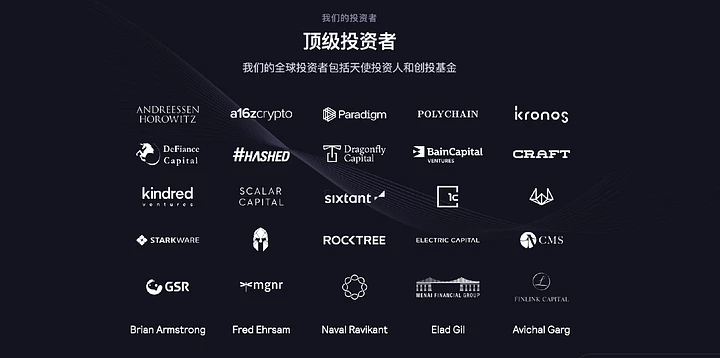
(4) In June 2021, it raised $65 million in Series C financing, led by Paradigm, with participation from liquidity providers QCP Capital, CMS Holdings, CMT digital, Finlink Capital, Sixtant, Menai Financial Group, MGNR, Kronos Research, and venture capital firms HashKey, Electric Capital, delphi digital, and StarkWare.
A total of $87 million was raised in four rounds of financing, with investment from industry-renowned institutions including Paradigm, Polychain Capital, Andreessen Horowitz (A 16 Z), Three Arrows Capital, and one of the largest liquidity providers on dydx, Wintermute, among others. The project has strong funding and ample resources for development.
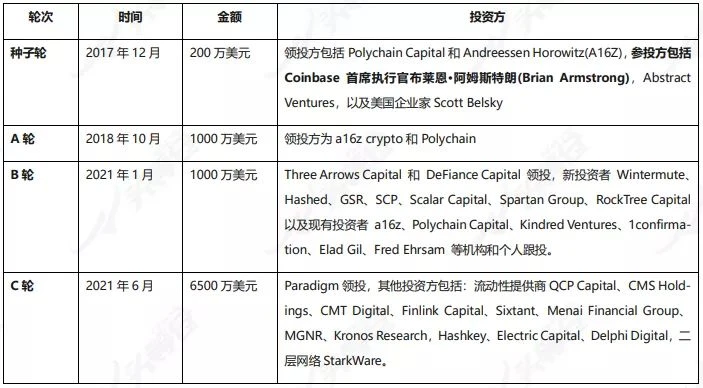
According to its token allocation plan, 27.73% of the tokens, that is, 277 million tokens, belong to the investors, and the average cost of the capital party is $0.31.
Considering the difference in valuation between the previous and later rounds, the cost of the last round of $65 million investment may be higher than $0.31. Part of the market attention received by dydx comes from its strong capital background, and this is also part of its current leading position in the field.
5. Fundamental Impact
dYdX is the world's first decentralized cryptocurrency derivatives trading platform.
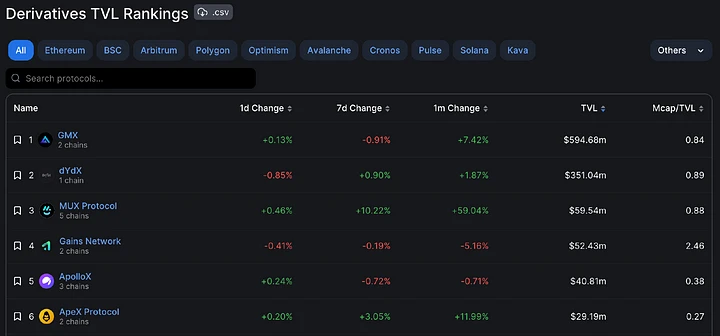
According to the data statistics of the defillama platform, the TVL of dYdX in the DeFi derivatives track reached $350 million, second only to GMX.
According to the data statistics of CoinMarketCap platform, in the DEX track, dYdX ranked first in the trading volume in the past 24 hours, with a market share of 23.3%, surpassing Uniswap V3.
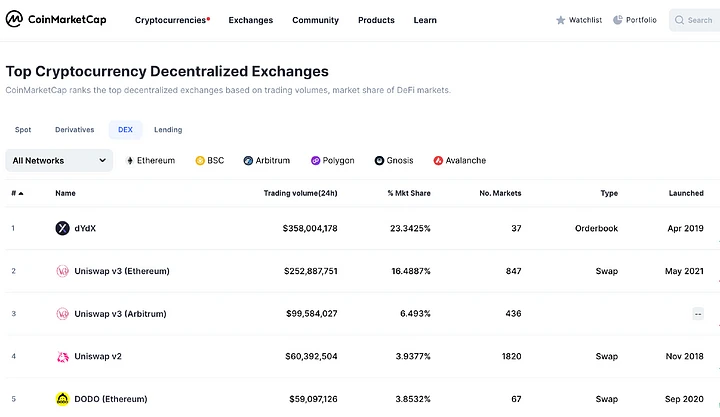
In addition, the dYdX platform currently only supports 37 trading pairs, which is much lower than other DEX trading platforms.
2. DYDX Token
1. Token Allocation
The total supply of DYDX tokens is 1 billion, which will be distributed over five years starting from August 3, 2021.
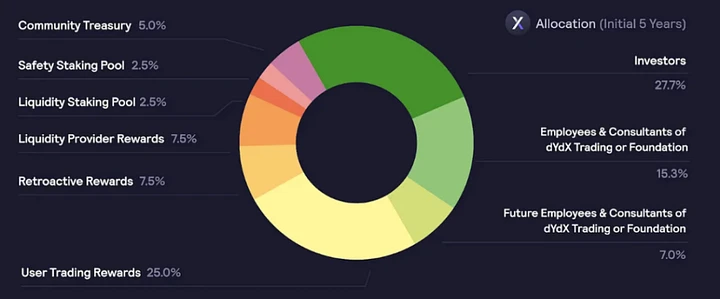
1) 50.00% of the supply will be used for the community, of which:
25.00% will be used as transaction rewards;
7.50% will be allocated for tracing mining rewards;
7.50% will be distributed to liquidity providers as rewards;
5.00% will go into the community treasury;
2.50% will be specifically used for users to pledge USDC to the liquidity staking pool;
The remaining 50%:
2) 27.73% will be allocated to past investors.
3) 15.27% will be distributed to founders, employees, advisors, and consultants.
4) 7.00% will be reserved for future employees and consultants of dYdX.
After 5 years, the maximum annual inflation rate will be 2.00% to support the platform's development.
2. Token Usage
The main purposes of DYDX token are as follows:
1. Participation in governance and voting
As a governance token, DYDX token has the function of voting and participating in governance.
2. Fee discounts
As a token of the trading platform, just like Binance Coin (BNB), DYDX holders can enjoy trading fee discounts based on their current holding size.
3. Staking
Staking is performed based on the proportion of each staker's total USDC holdings in the pool.In dYdX, pledgers will receive DYDX. If they want to withdraw USDC in the next period, they must request to unlock the USDC pledge at least 14 days before the end of the current period. If the pledgers do not request a withdrawal, the pledged USDC will be transferred to the next period.
III. Latest Developments and Future Possibilities
1. dYdX Chain
In the dYdX community, the current focus is on dYdX V4.
In the current version of dYdX, most components have been decentralized, but the order book and matching engine are still centralized components.
dYdX's goal is to achieve full decentralization. From dYdX's perspective, the decentralization of the system equals the decentralization of its least decentralized component. This means that every major component of V4 needs to be decentralized while maintaining high performance.
secondary title
Version V4 aims to achieve the decentralization of the order book and matching engine. The platform will no longer operate centralized components.

Compared to previous versions, V 4 is an independent L 1 blockchain, customized based on its own needs on Cosmos. It surpasses dYdX V 3 on L 2 StarkWare in terms of scalability and gas transaction fees, and it will receive more technical support from Cosmos.
In fact, the migration of dYdX from Ethereum to Cosmos is mainly aimed at enhancing the user trading experience.
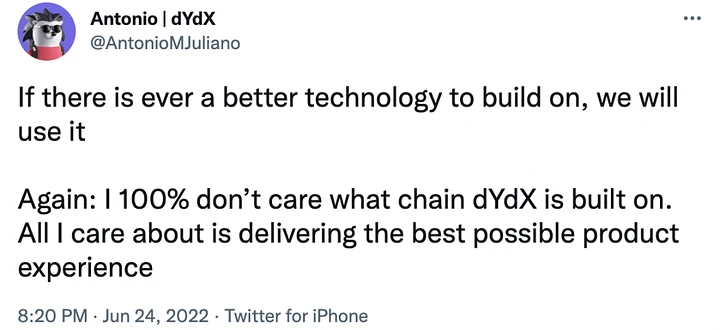
dYdX founder Antonio once said on Twitter:
"If there is a better technology to build dYdX, we will use it", "I 100% don't care about what chain dYdX is built on, I only care about providing the best product experience for users."
Implicitly, he believes that building dYdX on a Cosmos application chain is the optimal solution for improving user experience.
StarkNet co-founder @TobbyKitty also stated that the biggest reason for migrating to Cosmos is to allow dYdX token to operate as a validation node on the new chain and lock in the protocol value, which is not possible on L2.
On the future dYdX chain, users will pay transaction fees with DYDX tokens instead of ETH.
Currently, DYDX is equivalent to a cryptocurrency. Although the dYdX protocol has developed quite well, it operates on the Ethereum ecosystem and the transaction costs are paid in ETH.
Furthermore, the transaction revenue generated on the dYdX platform ultimately belongs to the project team.
The DYDX token lacks diverse use cases, thus the rapid development of the dYdX platform has not significantly boosted the price of DYDX token.
In fact, DYDX faces the same issues as UNI. Although the platform has developed quite well, the performance of the platform token is relatively average.
However, after migrating to Cosmos as a more autonomous L1 blockchain, dYdX will become the underlying foundational token for the entire dYdX Chain ecosystem, with its token value tightly linked to the depth of platform development.
The token required for staking to deploy nodes is DYDX, and the gas consumed during transactions also uses the DYDX token. The better the development of dYdX Chain, the more DYDX tokens will be consumed.
Furthermore, after the full decentralization implementation of version V 4, the community will take control away from dYdX Trading Inc. Therefore, the community can propose for more platform revenues to flow into the hands of DYDX token holders, rather than like in version V 4 where all revenues flowed into the platform.
This way, the DYDX token can capture more value from the development of the dYdX protocol.
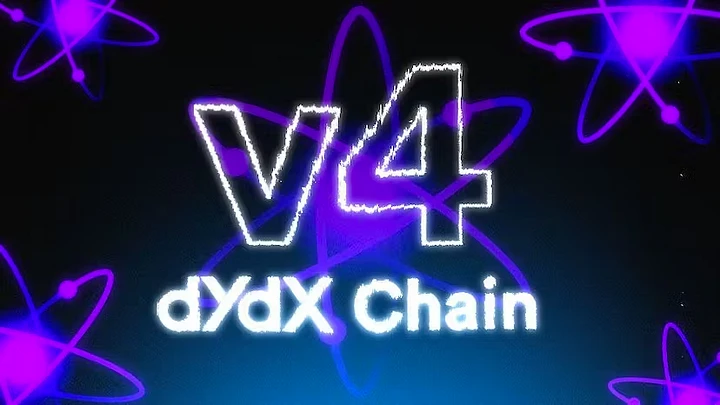
If V 3 is just an application chain on Ethereum L 2, then V 4 (dYdX Chain) is an independent L 1 blockchain with more operational space, of course.
2. Derivatives Trading Volume
In the traditional financial market, the trading volume of derivatives is much higher than that of spot trading.
However, in the cryptocurrency market, the current trading volume of derivatives is not much higher than that of spot trading, so there is still a lot of room for development in the derivatives trading volume of the cryptocurrency market.
Moreover, compared to the derivatives trading volume of Binance, dYdX's derivatives trading volume is only 2% of Binance's derivatives trading volume. As a leading decentralized derivatives trading platform, dYdX still has a lot of room for growth in its overall trading volume.
3, PoS Staking Tokens
After dYdX transitions to PoS consensus, it will run its own nodes, and running PoS nodes requires staking a certain amount of DYDX tokens. The higher the DYDX staking ratio, the more secure the dYdX Chain network.
In fact, the staking ratio of some PoS blockchains is over 50%. As we all know, the current circulation of DYDX tokens is only 15.63%. There will still be a considerable amount of tokens unlocked and released in the future.
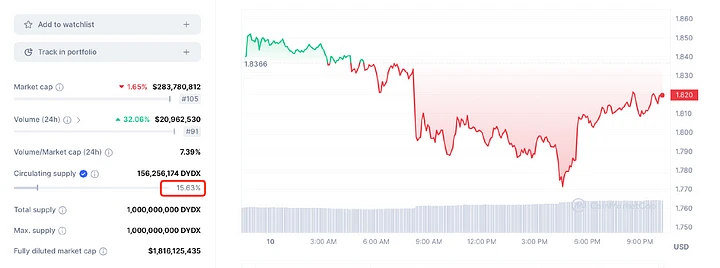
And PoS node staking will to some extent dilute the impact of DYDX token unlocking selling pressure, coupled with the consumption of DYDX tokens in dYdX Chain, and the linear unlocking of DYDX tokens in batches. Therefore, overall, the unlocking selling pressure on DYDX tokens will not have a significant impact on DYDX tokens.
4. Number of Listings on dYdX
Currently, dYdX platform only has trading pairs for 37 tokens, which is very limited compared to other DEX platforms.
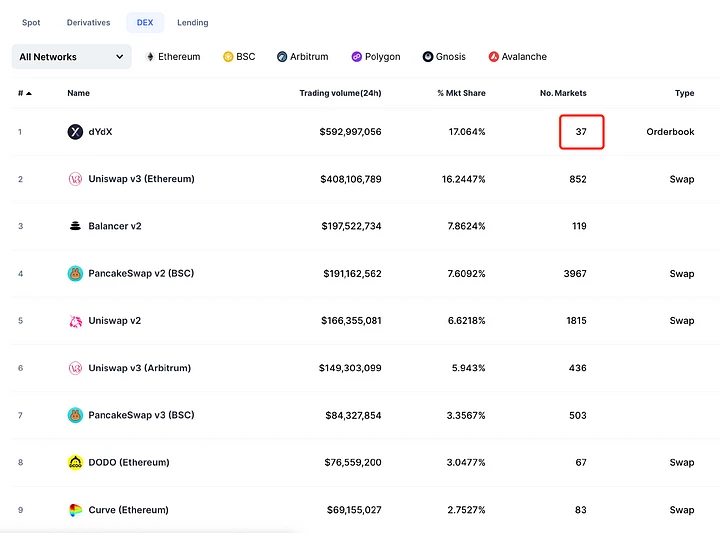
Although the number of currencies on the dYdX platform is lower than other DEX platforms, the trading volume of the platform is higher than other platforms.
Therefore, with the continuous development of dYdX, after the launch of version 4, the community can vote to list more tokens and there is still great potential for trading volume on the platform.
5. Regulatory Resistance
After the FTX platform collapsed, the trading volume on DEX platforms has shown significant growth. For dYdX, the platform's trading volume and DYDX token price have performed well.
The reason behind this is that the dYdX platform has a certain degree of regulatory resistance. In the future version 4, dYdX will be fully decentralized, and dYdX Trading Inc (the platform operator) will no longer run any centralized components. The management and control of dYdX will be handed over to the community, and decisions such as which tokens to list on the platform, how protocol revenues are distributed, and the future direction of the platform will be determined through community voting.
dYdX Chain's decentralized operations will help avoid unnecessary regulatory issues.

The dYdX team is an ambitious team. The team mentioned in the blog that one of dYdX's core values is to think ten times bigger. dYdX should focus on what it can achieve, rather than protecting what has been built so far. The goal of dYdX is to eventually become one of the largest exchanges in the cryptocurrency field.
IV. Competitive Comparison
In the decentralized derivatives space, the most notable projects are GMX and dYdX. Let's compare these two projects.
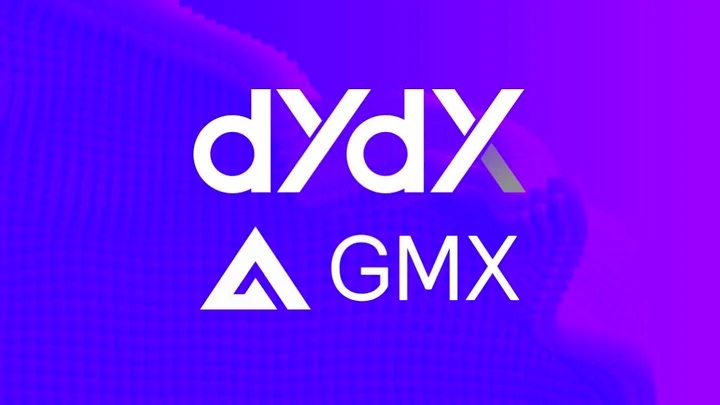
First, the two use different models.
dYdX uses the order book model, where users and users (or market makers) are counterparties, and the platform operates the orders of both buyers and sellers.
GMX, on the other hand, uses the AMM (automated market maker) model, where users and the asset pool are counterparties.
Now, let's analyze from three aspects: liquidity, price discovery mechanism, and funding rate.
1. Liquidity
The liquidity of a cryptocurrency exchange refers to the quantity of cryptocurrencies that can be bought and sold on the exchange, as well as the stability of their prices.
And the oracle does not have the power to set prices and does not affect the price. It can only passively receive the feed price from the oracle, and the party receiving the price can only digest the price changes on their own. This may result in oracle attacks. For example, GMX was attacked in September 2022 due to zero slippage.
Because GMX adopts a zero slippage mechanism, zero slippage actually means that the attacker always has unlimited liquidity and low attack costs.
If a user goes long on AVAX with a transaction volume of 1 billion USD on the GMX platform, according to common sense, such a high transaction volume will definitely drive up the price of AVAX. However, GMX uses a zero slippage mechanism and opens a position based on the price quote given by the oracle.
But this large volume of transactions will definitely drive up the price of AVAX tokens on other trading platforms. Assuming a 20% increase, the oracle will only feedback the latest AVAX price (which has increased by 20%) to the GMX platform, and then the position can be closed based on the latest price that has increased by 20%.
On the GMX platform, due to the adoption of the oracle price feed and the zero slippage mechanism, if the future trading volume on the platform is huge but the source of price information still comes from external sources, it is very likely to be susceptible to price attacks.
5. Market Value Forecast
Currently, the price of GMX is around $2, with a market value of just over $200 million, ranking around 100, and GMX market value ranking at 80.
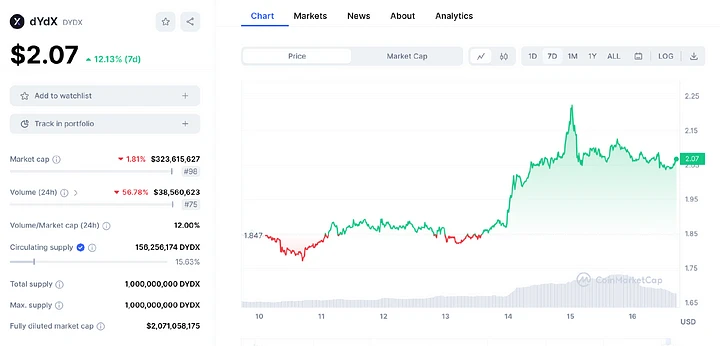
Observing the historical K-line chart of the DYDX token, it can be seen that the highest increase in DYDX is after the token issuance and the start of mining, and the price has risen to over $27. However, due to the lack of sufficient applications given by the platform, DYDX has always lacked enough use cases. Although dYdX has developed quite well, the price of DYDX has remained low for a long time.
Currently, DYDX's price is far from its all-time high, with a decline of more than 93%. It is basically in a low position for a long time, even in an oversold state.
But with the launch of version 4, these issues will be resolved. The community will allocate more of the platform's revenue to DYDX holders through voting.
Of course, one unavoidable problem facing the DYDX token is the large unlocking selling pressure. However, after the launch of version 4, token staking is likely to absorb the unlocking selling pressure.
In addition, the trading volume of decentralized derivatives is currently very low. With the arrival of global regulatory policies, more trading will be transferred to decentralized trading platforms. There is a large development space for decentralized derivatives in the future. Based on the above predictions, in the future bull market, DYDX's market value is likely to enter the top 30-50, and it is not ruled out that the market value will enter the top 30. The price of the token DYDX, conservatively estimated, will increase by 5-10 times, or even higher. The future development of dYdX will continue to be monitored.










